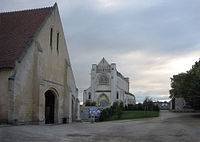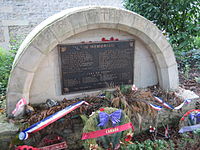
The Abbey in September 2006, after extensive restoration.
The Ardenne Abbey massacre occurred during the Battle of Normandy at the Ardenne Abbey, a Premonstratensian monastery in Saint-Germain-la-Blanche-Herbe, near Caen, France. In June 1944, 20 Canadian soldiers were illegally executed at the abbey by members of the 12th SS Panzer Division Hitlerjugend.
Murders at the Ardenne Abbey[]
During the Normandy Campaign, Brigadeführer Kurt Meyer, commander of the 25th Panzer Grenadier Regiment, used the Ardenne Abbey for his regimental headquarters, as the turret allowed for a clear view of the battlefield.[1] The abbey is the location where in June 1944, 20 Canadian soldiers were illegally executed by members of the 12th SS Panzer Division.
Both the method by which the killings were carried out and upon whom the blame rests remain points of contention. Some basic facts, however, are certain. During the evening of 7 June, 11 Canadian prisoners of war, soldiers from the North Nova Scotia Highlanders and the 27th Armoured Regiment (The Sherbrooke Fusilier Regiment), were shot in the back of the head. This was a flagrant violation of the Geneva Convention (of which Germany was a signatory) and therefore these actions constituted a war crime.
Of the North Nova Scotia Highlanders were:
- Private Ivan Crowe
- Private Charles Doucette
- Corporal Joseph MacIntyre
- Private Reginald Keeping
- Private James Moss
Of the 27th Armoured Regiment (The Sherbrooke Fusiliers Regiment) were:
- Trooper James Bolt
- Trooper George Gill
- Trooper Thomas Henry
- Trooper Roger Lockhead
- Trooper Harold Philip
- Lieutenant Thomas Windsor
The following day, 8 June, seven more POWs from the North Nova Scotia Highlanders were also executed:
- Private Walter Doherty
- Private Hollis McKeil
- Private Hugh MacDonald
- Private George McNaughton
- Private George Millar
- Private Thomas Mont
- Private Raymond Moore
On 17 June, two more Canadian soldiers, Lieutenant Fred Williams and Lance Corporal George Pollard, were also believed to have been killed at or around the abbey.[2]
Discovery of the bodies[]
After liberating the Ardenne Abbey on 8 July, members of the Regina Rifle Regiment discovered the body of Lieutenant Williams; Lance Corporal Pollard was never found. The bodies of those killed on 7 and 8 June were not found until the winter and spring of 1945, when inhabitants from the abbey accidentally discovered remains throughout the premises. Examinations of the remains revealed that the soldiers had either been shot or bludgeoned directly in the head.[3] All the remains were taken to the cemeteries at Beny-sur-Mer or Bretteville-sur-Laize, except for Private McKeil, who was taken to Ryes War Cemetery.
Trial of Kurt Meyer[]
Following a year of investigations from August 1944 to August 1945, the Canadian War Crimes Commission (CWCC), led by Lieutenant-Colonel Bruce Macdonald, strove to discover the details of the murders and who bore the responsibility.[4] As commander of the regiment, Kurt Meyer remained the prime suspect. At Meyer’s war crimes trial in December 1945, the incident at the Abbaye formed the core of the charges. In total, five charges were laid against him:
- Inciting and advising soldiers under his command to refuse quarter to Allied troops.
- Commanding his troops to kill 23 POWs at or near the villages of Buron and Authie on 7 June 1944.
- Commanding his troops, on 8 June 1944, to kill seven prisoners of war at the Abbaye Ardenne, and as a result of such orders the prisoners were shot and killed.
- (Alternative to third charge) Responsibility for the killing of seven Canadian POWs at the Abbaye Ardenne on 8 June 1944.
- Ordering for the killing of 11 Canadian POWs at the Abbaye Ardenne on 7 June 1944.[5]
Former SS Private Alfred Helzel was the prosecution’s first major witness. While in prison in Quebec, Helzel revealed that in June 1944 Meyer had directed his troops to take no prisoners; on the stand, however, Helzel denied that Meyer made such a declaration.[6] Macdonald eventually managed to have Helzel verify his original statement, thus helping to establish Meyer’s guilt.[7]
Citizens of the towns of Authie and Buron testified against the 12th SS and the various atrocities committed against Canadian soldiers. Canadian soldiers themselves testified, the most important being Sergeant Stanley Dudka. He maintained that his column of prisoners arrived at the Abbaye Ardenne on 7 June, after which military police demanded 10 volunteers step forward. Since no one volunteered, 10 men were randomly taken, including Private Moss, later identified as one of the men executed at the Abbaye.[8]
The prosecution’s central witness, however, was German soldier Jan Jesionek. At the Abbaye on 8 June 1944, Jesionek was approached by two SS troopers who were escorting seven Canadian prisoners, and watched as the POWs were directed into a stall adjoining the Abbaye. One of the troopers asked for the regimental commander, whereby Jesionek led him to Kurt Meyer. In response to learning of the seven prisoners, Meyer reportedly said: ‘What should we do with these prisoners; they only eat up our rations?’ Afterwards, he turned to one of the officers, spoke softly so that others could not hear, and then announced: ‘In the future, no more prisoners are to be taken.’[9] Jesionek then saw each prisoner questioned by the officer to whom Meyer had spoken. A name was called out, a prisoner walked up from the passageway leading to the garden in the Abbaye. As soon as the prisoner turned, the officer shot him in the head with a machine pistol; this was repeated for the remaining six prisoners. After the officer and guards left, Jesionek and three fellow drivers examined the bodies, all lying in the garden and surrounded by blood. According to Jesionek, the Canadians realized what was happening, each prisoner shaking hands with his comrades before walking to the garden and being shot.[9] Uncertainty over Meyer’s commands remained since Jesionek never heard Meyer give the order to kill the Canadians.
Meyer originally claimed to have had no knowledge of the murders at the Abbaye. He later insisted, however, that he was aware of the bodies’ presence but had not seen them until two days after the killings. Disgusted, Meyer apparently ordered for the burial of the bodies and the admonishment, albeit unsuccessfully, of those responsible. These claims were refuted by French teenagers, however, who lived in the Abbaye and testified that no bodies were visible in the garden when they went there the day after the murders.[10] Throughout the trial, Meyer maintained that he never commanded his troops to not take prisoners.
Outcome of Trial[]

A memorial to the executed Canadian soldiers in the garden of the Abbaye.
Meyer was found guilty of inciting his troops to commit murder and of being responsible as a commander for the killings at the Abbaye; he was acquitted on the second and third charges.[11] Sentenced to death on 28 December 1945, his sentence was commuted to life imprisonment on 14 January 1946.[12] After serving nearly nine years in prison, Meyer was released on 7 September 1954.[13]
Present[]
The role Meyer played in the execution of the twenty Canadian prisoners remains a point of contention. Currently, in the garden of the Abbaye rests a memorial to the soldiers, unveiled on 6 June 1984. The inscription, followed by the names of those killed, reads: “IN MEMORIAM. ON THE NIGHT OF 7-8 JUNE 1944, EIGHTEEN CANADIAN SOLDIERS WERE MURDERED IN THIS GARDEN WHILE BEING HELD HERE AS PRISONERS OF WAR. TWO MORE PRISONERS DIED HERE, OR NEARBY, ON 17 JUNE 1944. LEST WE FORGET.”[14]
References[]
Bibliography[]
- Brode, Patrick. Casual Slaughters and Accidental Judgments: Canadian War Crimes Prosecutions, 1944-1948. Toronto: The Osgoode Society for Canadian Legal History, 1997.
- Campbell, Ian. Murder at the Abbaye: The Story of Twenty Canadian Soldiers Murdered at the Abbaye d’Ardenne. Ottawa: The Golden Dog Press, 1996.
- Margolian, Howard. Conduct Unbecoming: The Story of the Murder of Canadian Prisoners of War in Normandy. Toronto: University of Toronto Press, 1998.
- Priestman, Karen. The Kurt Meyer Case: The Press and the Canadian People’s Response to Canada’s First War Crimes Trial. Waterloo: Wilfrid Laurier University Press, 2003.
- Veterans Affairs Canada. "Abbaye d’Ardenne" Accessed 8 July 2013.
Coordinates: 49°11′47″N 0°24′50″W / 49.1964917°N 0.4138917°W
Other Sources[]
Visit to the memorial at Abbey Ardenne, with photographs.
The original article can be found at Ardenne Abbey massacre and the edit history here.